Are You 21 Or Over?
YesOr
No By clicking yes, you certify that you are over 21 years old. By using this website, you agree to our legal disclaimer.Table of Contents

More than just heavy buds can come from cannabis growing. Maybe among the most underappreciated yet essential components of the plant is the sugar leaf. Little, trichome-dusted leaves are essential for post-harvest processing and may be used in so many different ways to maximize your crop. We will go over in this post what cannabis sugar leaves are, how to spot them, and what kinds of uses they may be put to for the best output.
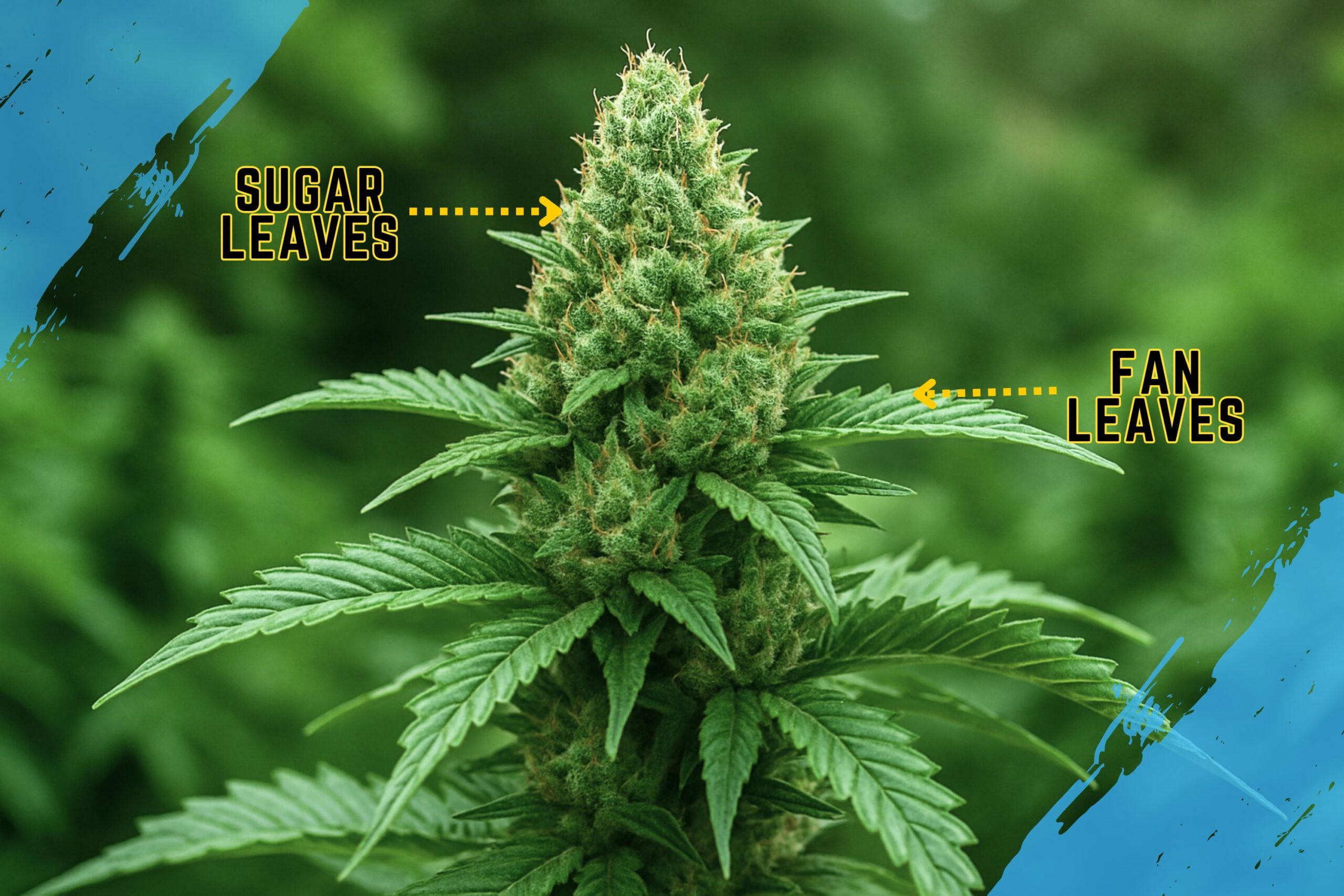
The small, sticky leaves that show out from inside the cannabis flower are sugar leaves. Sugar leaves contrast with fan leaves, large and mostly in charge of photosynthesis. Within the floral arrangement, sugar leaves are found, and as the plant ages, trichomes cover them. Weed sugar leaves are valuable and powerful since these trichomes include terpenes and cannabinoids.
Particularly with high-resin strains, sugar leaf trichome density will be somewhat similar to low-grade buds. Their name comes from the sweet, icy look this trichome stacking produces. Sugar leaves are a great basis material for concentrates, edibles, and infusions, even though not usually smoked alone because of chlorophyll and astringency.
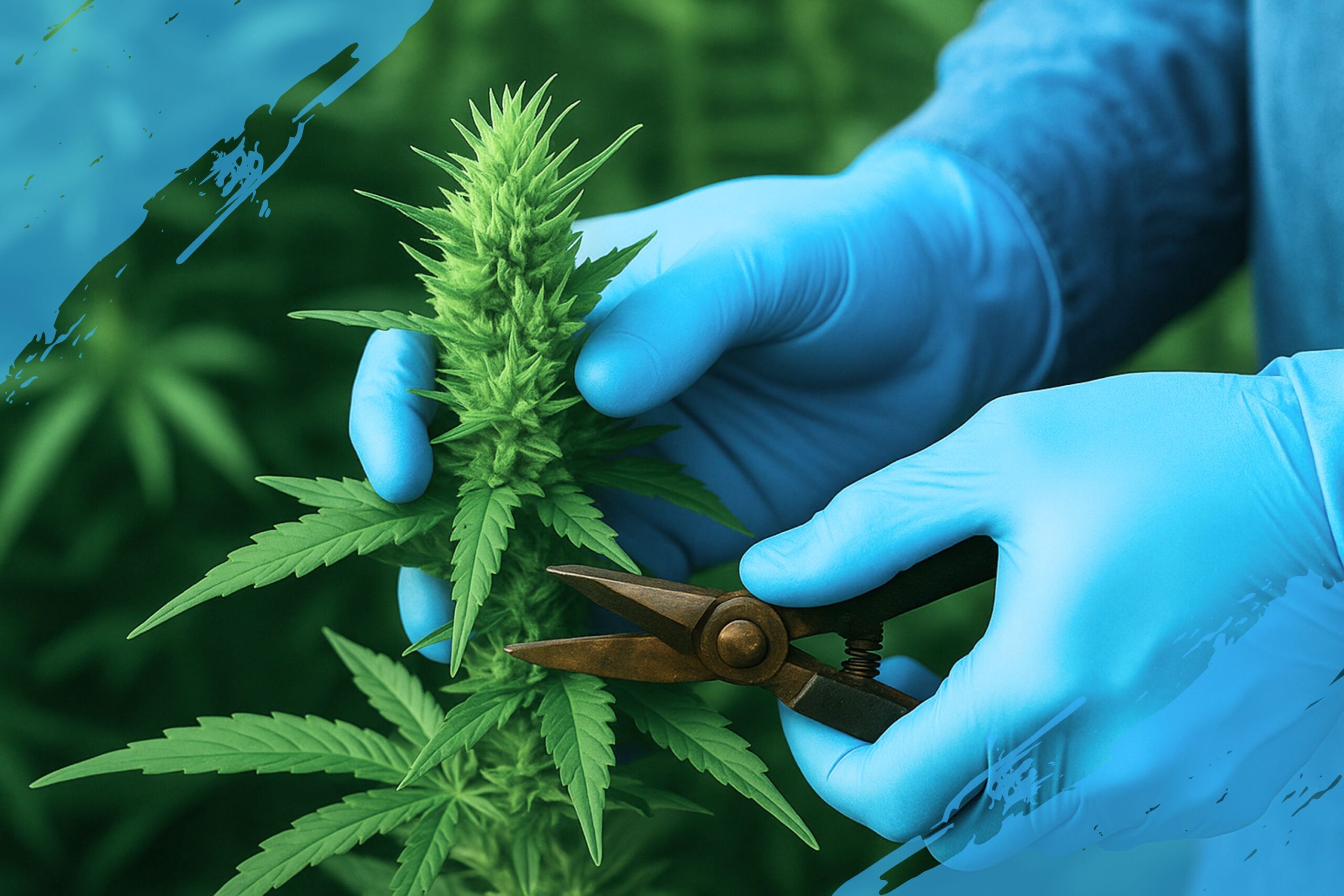
The maintenance of the potency of sugar leaves depends critically on timing and technique in cannabis harvesting. By removing sugar leaves when they are still pliable and full of volatile terpenes, wet trimming—that is, the removal of the leaves straight after harvesting—allows growers to Wet cutting reduces the possibility of losing trichomes.
Gloves are required for quality and to protect the resin; they should not be handled too much while trimming. Every handling disturbs trichomes and lowers overall cannabis output. To prevent sticking, gather trimmings on parchment paper or silicone mats; a trim bin with a mesh screen will help to capture loose kief that comes off during processing. While manual trimming is still best, machine trimmers can help to speed up bulk manufacturing processes.
1. Making Cannabutter with Cannabis Oil
For fat infusions like butter and oil, sugar leaves are the best since of high trichome levels. Edibles like brownies, cookies, and candy build on the infusions. To activate THC or CBD before infusion, decarboxylate leaves at 220°F (104°C) for 30–45 minutes. To give low, steady heat for infusion, use a slow cooker or double boiler.
To get the maximal surface area before infusing decarboxylated sugar leaves in the fat, finely powder them for even better infusion. While filtering with cheesecloth guarantees a clean result, stirring sometimes during infusion helps to spread the cannabis uniformly. Some home growers additionally include leucithin for improved absorption and more potency when consumed.
2. Making Rosin, Kief, and Hash
Among the materials of best quality for solventless concentration is sugar leaf. Mesh sifting bags or dry ice let farmers separate kief from sugar leaf. Using a heat press, this kief may now be squeezed into hash or rosin, producing a strong, solvent-free product as good as anything from dispensaries.
With great accuracy, dry sifting sugar leaf across fine mesh screens of different micron diameters helps to separate the trichome heads from plant material Either uncooked in joints and bowls or carefully heated and pressed to create classic hash bricks, kief collected can be Low heat and high pressure rosin presses help sugar leaf resin to become full-melt dabs, so preserving all the natural terpene character, so attaining a purer, more concentrated extract.
3. Tobacco Extracts and Cannabis Tinctures
Tinctures can be produced from sugar leaves by extracting cannabinoids using Everclear, a high-proof alcohol. Easy to administer, long-lasting, and fast acting are these alcohol extracts. Before the solution is filtered, decarboxylated sugar leaves are steeped in alcohol for weeks to be eaten sublingually or mixed with beverages.
The jar must be regularly shaken during tincture preparation to evenly extract the leaves. Filtering will help to produce a smooth final product using coffee filters or micron bags. To create RSO (Rick Simpson Oil), a highly concentrated extract utilized in medical uses, the tinctures may also be reduced slowly over low heat or made into sublingual sprays.
Sugar leaves taste more harshly of smoke, even if they are potent, since they have more chlorophyll than cured bud. To extend their supply, some users choose to mix sugar leaves with buds, but they could discover that the taste and texture deteriorate as a result.
For excellent smokers, rolling sugar leaves alone is not advised; yet, when combined with premium flower or concentrates, they could provide strength without appreciably changing flavor. Sugar leaves evaporated at temperatures less than 340–360°F (171–182°C) can provide cannabinoids effectively while limiting harshness, therefore providing a likely cure for thrifty consumers.
Apart from leisure use, sugar leaves have medicinal value if used topically or in tea. Pouring fat or alcohol on decarboxylated and dry sugar leaves produces rich balms for dermatitis, inflammation, or discomfort, since cannabis is insoluble in water.
Herbs like calendula or comfrey will only enhance the skin-healing properties of saturating sugar leaves in coconut oil or olive oil. These topical treatments will help ease localized pain, arthritis, and muscular discomfort. When weaker, medicinal teas will produce soothing relaxation, especially if brewed in milk or other fatty fluids to help the absorption of cannabis.
Sugar leaves must be properly stored if their levels of cannabinoids are to remain constant and mold is to be avoided. Store dried and cured sugar leaves in tightly sealed containers—ideally dark glass jars—in areas free of heat, light, or humidity. Store using the humidity packs with a consistent Relative Humidity of 55–62%.
Because THC breaks down into CBN, which increases sleep-inducing effects, label containers with strain name and date of harvest to track potency over time. Sugar leaves and freezing them for commercial sale or long-term storage, vacuum-sealed, will help to avoid degradation. To prevent moisture condensation and consequent mold, however, slow freezing at room temperature in a sealed container is advised.
The best-kept secret of a cannabis grower is sugar leaves. Far from waste, sugar leaves are loaded with trichomes simply ready for use in wellness products, extracts, and premium infusions. Utilizing appropriate harvesting, curing, and processing of sugar leaves, we may increase the value and efficiency of every cannabis harvest so that none of this amazing plant is ever lost.
Sugar leaves are a great help in smart farming as sustainable methods and the best use of plants are in demand. Including sugar leaves in your post-harvest process helps both hobby and commercial growers to have a more profitable and complete growth cycle.
1. Can you create vape cartridges using sugar leaves?
Indeed, sugar leaves can be used for vape cartridge oil; but, first, they must be solvent-based extracted—that is, CO₂ or ethanol—then winterized to strip away waxes for a pure, vape-ready oil.
2. Are fresh sugar leaves appetizing?
Raw sugar leaves carry inactive cannabinoids (THCA, CBDA) and are not psychoactive, even if they are not poisonous. Raw consumption of them will not have any notable impact and might irritate the digestive.
3. Could sugar leaves be juiced using the fan leaf technique?
Indeed, they have more resin, so although sparingly, they can. They can be combined with fruit and vegetables and consumed as a non-psychoactive, high in cannabinoids drink.
4. Are the sugar leaves produced by all cannabis kinds the same count?
Sugar leaf quantity and size are environmental and strain genetic depending. Some strains grow thicker buds with fewer sugar leaves; others are leafier.
5. Sugar leaves keep for what length of time before their potency starts to drop?
Maintaining sealed containers in a cold, dark environment, sugar leaves stores for up to a year. THC then progressively deteriorates to CBN, therefore reducing intoxicating effects.

Curious about growing weed in a healthy, effective way? Welcome to the realm of weed hydro! This method uses water instead of soil, delivering n
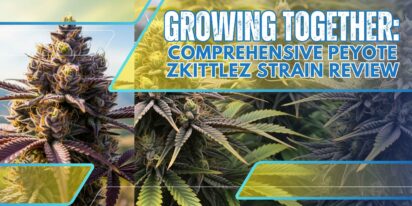
Peyote Zkittlez is a unique cannabis strain that has quickly gained dedicated followers among enthusiasts and patients alike. Its parentage—Zk
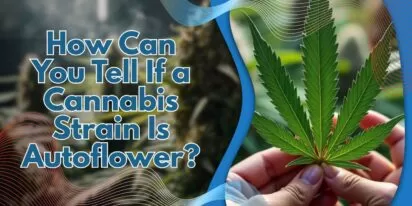
As growers, we want strains that work well, are strong, and are of good quality. Autoflowering cannabis strains are a big step forward for both
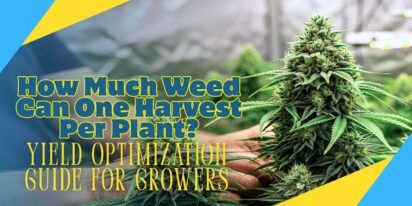
Pot growers always ask the same basic question: How much weed does a weed plant produce? The answer is complex and depends on a multitude of var

Ever had the room spin after a few hits? You're not alone. Figuring out how to prevent getting dizzy high can make your cannabis experience a wh
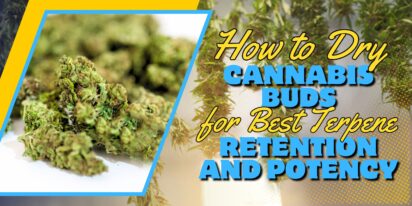
Drying cannabis properly is a critical process in preserving the plant's full aroma and flavor and its psychoactive abilities. Tampering with th

Ever caught yourself a bit too high and all of a sudden in need of being normal? Whether you're heading out for munchies or bumping into someone

Looking for sage advice on how not to get pinched with weed without batting an eye? Attempting to protect your stash from gossipy roommates, sno
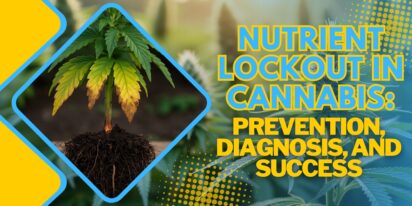
Nutrient lockout, also known as nutrient binding or chemical antagonism, is a significant issue in cannabis cultivation that negatively impacts
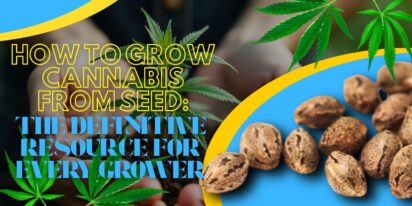
Germination is the most critical initial stage in growing healthy, high-quality cannabis plants. During germination, the dormant seed becomes a
Are You 21 Or Over?
YesOr
No By clicking yes, you certify that you are over 21 years old. By using this website, you agree to our legal disclaimer.
Excellent blog here Also your website loads up very fast What web host are you using Can I get your affiliate link to your host I wish my web site loaded up as quickly as yours lol
Your writing is not only informative but also incredibly inspiring. You have a knack for sparking curiosity and encouraging critical thinking. Thank you for being such a positive influence!
Simply wish to say your article is as amazing The clearness in your post is just nice and i could assume youre an expert on this subject Well with your permission let me to grab your feed to keep updated with forthcoming post Thanks a million and please carry on the gratifying work
Somebody essentially lend a hand to make significantly articles Id state That is the very first time I frequented your website page and up to now I surprised with the research you made to make this actual submit amazing Wonderful task
Your blog is a beacon of light in the often murky waters of online content. Your thoughtful analysis and insightful commentary never fail to leave a lasting impression. Keep up the amazing work!
Thank you for the auspicious writeup It in fact was a amusement account it Look advanced to more added agreeable from you By the way how could we communicate
Your blog is a constant source of inspiration for me. Your passion for your subject matter shines through in every post, and it’s clear that you genuinely care about making a positive impact on your readers.
Your blog is a constant source of inspiration for me. Your passion for your subject matter is palpable, and it’s clear that you pour your heart and soul into every post. Keep up the incredible work!
Your articles never fail to captivate me. Each one is a testament to your expertise and dedication to your craft. Thank you for sharing your wisdom with the world.
Your blog is a testament to your dedication to your craft. Your commitment to excellence is evident in every aspect of your writing. Thank you for being such a positive influence in the online community.
Your writing has a way of resonating with me on a deep level. I appreciate the honesty and authenticity you bring to every post. Thank you for sharing your journey with us.
Your blog is a true gem in the world of online content. I’m continually impressed by the depth of your research and the clarity of your writing. Thank you for sharing your wisdom with us.
Hi i think that i saw you visited my web site thus i came to Return the favore Im attempting to find things to enhance my siteI suppose its ok to use a few of your ideas
Somebody essentially help to make significantly articles Id state This is the first time I frequented your web page and up to now I surprised with the research you made to make this actual post incredible Fantastic job
Usually I do not read article on blogs however I would like to say that this writeup very compelled me to take a look at and do so Your writing taste has been amazed me Thanks quite nice post
Your blog has quickly become one of my favorites. Your writing is both insightful and thought-provoking, and I always come away from your posts feeling inspired. Keep up the phenomenal work!
Every time I visit your website, I’m greeted with thought-provoking content and impeccable writing. You truly have a gift for articulating complex ideas in a clear and engaging manner.
Hey there You have done a fantastic job I will certainly digg it and personally recommend to my friends Im confident theyll be benefited from this site
I have read some excellent stuff here Definitely value bookmarking for revisiting I wonder how much effort you put to make the sort of excellent informative website
Nice blog here Also your site loads up very fast What host are you using Can I get your affiliate link to your host I wish my site loaded up as quickly as yours lol
What i do not understood is in truth how you are not actually a lot more smartlyliked than you may be now You are very intelligent You realize therefore significantly in the case of this topic produced me individually imagine it from numerous numerous angles Its like men and women dont seem to be fascinated until it is one thing to do with Woman gaga Your own stuffs nice All the time care for it up
Your blog is a beacon of light in the often murky waters of online content. Your thoughtful analysis and insightful commentary never fail to leave a lasting impression. Keep up the amazing work!
Your blog is a breath of fresh air in the often stagnant world of online content. Your thoughtful analysis and insightful commentary never fail to leave a lasting impression. Thank you for sharing your wisdom with us.
Your blog is a beacon of light in the often murky waters of online content. Your thoughtful analysis and insightful commentary never fail to leave a lasting impression. Keep up the amazing work!
Usually I do not read article on blogs however I would like to say that this writeup very compelled me to take a look at and do it Your writing style has been amazed me Thank you very nice article
Your writing has a way of resonating with me on a deep level. I appreciate the honesty and authenticity you bring to every post. Thank you for sharing your journey with us.
This hydroponics guide is quite the buzz, seriously! Who knew growing weed without dirt could be so complicated yet potentially rewarding? The breakdown of systems like DWC and NFT is helpful, though I suspect my cat might confuse the air pump for a toy. The idea of cleaner buds is tempting, especially since explaining hydro weed to my non-growing friends might get messy. And the bit about potential dizziness from hydro weed? Perfect, now I have an excuse for why I always stumble a bit after a grow session. Still, the promise of faster grows and higher yields is hard to ignore, even if it means more trips to the pH meter than to the coffee shop. Overall, a cultivating read for the curious grower!